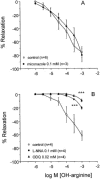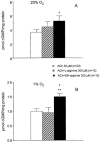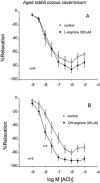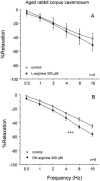Activation and potentiation of the NO/cGMP pathway by NG-hydroxyl-L-arginine in rabbit corpus cavernosum under normoxic and hypoxic conditions and ageing
- PMID: 12522074
- PMCID: PMC1573653
- DOI: 10.1038/sj.bjp.0705027
Activation and potentiation of the NO/cGMP pathway by NG-hydroxyl-L-arginine in rabbit corpus cavernosum under normoxic and hypoxic conditions and ageing
Abstract
1 When nitric oxide synthase (NOS) produces NO from N(G)-hydroxy-L-arginine (OH-arginine) instead of L-arginine, the total requirement of molecular oxygen and NADPH to form NO is reduced. The aim of this work was to evaluate the effects of OH-arginine on the contractility of rabbit corpus cavernosum (RCC) and to compare the capacities of L-arginine and OH-arginine to enhance NO-mediated responses under normoxic and hypoxic conditions and in ageing, as models of defective NO production. 2 OH-arginine, but not L-arginine, was able to relax phenylephrine-contracted rabbit trabecular smooth muscle. OH-arginine-induced relaxation was inhibited by the NOS-inhibitor, L-NNA (300 microM), and by the guanylyl cyclase inhibitor, ODQ (20 microM), while it was not affected by the cytochrome P450 oxygenase inhibitor, miconazole (0.1 mM). Administration of OH-arginine, but not L-arginine, produced a significant increment of cGMP accumulation in RCC tissue. 3 Relaxation elicited by OH-arginine (300 microM) was still observed at low oxygen tension. The increase of cGMP levels induced by ACh (30 microM) in RCC was significantly enhanced by addition of OH-arginine (300 microM) in normoxic conditions, as well as under hypoxia, while L-arginine did not alter the effects of ACh on cGMP accumulation. 4 Endothelium-dependent and nitrergic nerve-mediated relaxations were both significantly reduced in RCC from aged animals (>20-months-old) when compared with young adult rabbits (5-months-old). Treatment with OH-arginine (300 microM) significantly potentiated endothelium-dependent and neurogenic relaxation in corpus cavernosum from aged rabbits, while L-arginine (300 microM) did not have significant effects. 5 Results show that OH-arginine promotes NO-mediated relaxation of RCC and potentiates the NO-mediated responses induced by stimulation of endogenous NO generation in hypoxic and aged tissues. We propose that the use of OH-arginine could be of interest in the treatment of erectile dysfunction, at least in those secondary to defective NO production.
Figures









References
-
- ANGULO J., RODRIGUEZ-MAÑAS L., PEIRO C., NEIRA M., MARIN J., SANCHEZ-FERRER C.F. Impairment of nitric oxide mediated relaxations in anaesthetized autoperfused streptozotocin-induced diabetic rats. Naunyn-Schmiedeberg's Arch. Pharmacol. 1998;358:529–537. - PubMed
-
- BURNETT A.L. Role of nitric oxide in the physiology of erection. Biol. Reprod. 1995;52:485–489. - PubMed
-
- BURNETT A.L., LOWENSTEIN C.J., BREDT D.S., CHANG T.S., SNYDER S.H. Nitric oxide: A physiologic mediator of penile erection. Science. 1992;257:401–403. - PubMed
-
- CERNADAS M.R., SANCHEZ DE MIGUEL L, GARCIA-DURAN M., GONZALEZ-FERNANDEZ F., MILLAS I., MONTON M., RODRIGO J., RICO L, FERNANDEZ P., DE FRUTOS T., RODRIGUEZ-FEO J.A., GUERRA J., CARAMELO C., CASADO S., LOPEZ-FARRE A. Expression of constitutive and inducible nitric oxide synthases in the vascular wall of young and aging rats. Circ. Res. 1998;83:279–286. - PubMed
Publication types
MeSH terms
Substances
LinkOut - more resources
Full Text Sources
Medical

